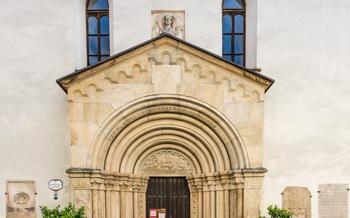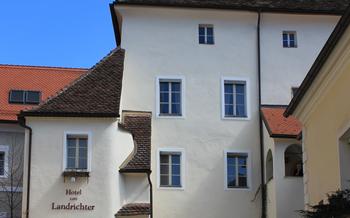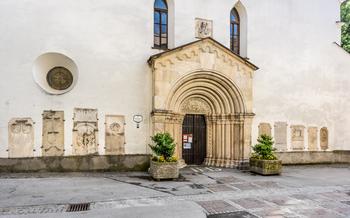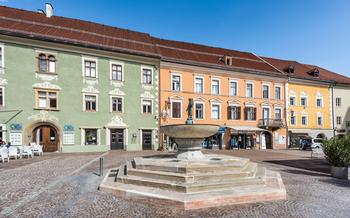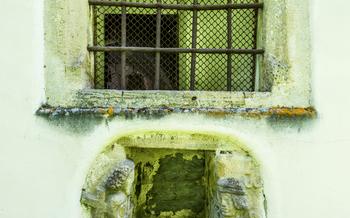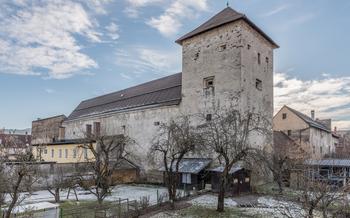
Heinrich Harrer Museum
- A Journey into Adventure and Discovery
- Unveiling the Himalayan Odyssey
- Stepping into the Museum's Realm
- A Glimpse into Harrer's World
- Tracing the Path to Tibet
- Confronting the Challenges of Internment
- Witnessing the Tibetan Landscape
- Encountering the Dalai Lama
- Exploring Harrer's Legacy
- Educational Programs and Workshops
- Temporary Exhibitions and Special Events
- Museum Shop and Souvenirs
- Accessibility and Facilities
- Insider Tip: Unveiling Hidden Treasures
A Journey into Adventure and Discovery
Heinrich Harrer, a legendary Austrian mountaineer, explorer, and author, embarked on a thrilling journey that would shape his life and leave an indelible mark on the world of exploration. Driven by an insatiable thirst for adventure and a profound fascination with the unknown, Harrer set out to conquer some of the world's most formidable peaks. His daring exploits in the Himalayas, particularly his attempt to scale Nanga Parbat in 1938, cemented his status as a fearless adventurer. Fate, however, had other plans for Harrer. The outbreak of World War II led to his capture and internment in British India, where he spent several years as a prisoner of war. Yet, even in the face of adversity, Harrer's indomitable spirit and unwavering determination shone through. He managed to escape from his captors and embarked on an arduous journey through Tibet, where he would forge a lifelong friendship with the Dalai Lama, the spiritual and temporal leader of Tibet.
The Heinrich Harrer Museum, located in the charming town of Sankt Veit an der Glan in Austria, is a testament to Harrer's extraordinary life and achievements. Dedicated to preserving and showcasing his legacy, the museum offers visitors a captivating glimpse into the world of this remarkable adventurer. Through a diverse collection of artifacts, photographs, and personal belongings, the museum invites visitors to embark on a journey of discovery, retracing Harrer's footsteps from his early mountaineering exploits to his transformative experiences in Tibet.
One of the most compelling aspects of Harrer's story is his encounter with the Dalai Lama. Their friendship, forged during Harrer's time in Tibet, would profoundly impact both men. Harrer became a trusted advisor and tutor to the young Dalai Lama, sharing his knowledge of the outside world and helping to shape his vision for Tibet's future. This unique bond between two men from vastly different backgrounds stands as a testament to the power of friendship, understanding, and mutual respect.
Unveiling the Himalayan Odyssey
Heinrich Harrer's daring attempt to climb Nanga Parbat in 1938, the ninth-highest mountain in the world, was a testament to his unwavering determination and love for mountaineering. Along with his climbing partner, Peter Aufschnaiter, Harrer embarked on this perilous expedition, facing treacherous weather conditions, altitude sickness, and the unforgiving terrain of the Himalayas. Despite their valiant efforts, they were forced to retreat due to the harsh conditions, but their resilience and tenacity remained unbroken.
The outbreak of World War II brought an unexpected turn of events. Harrer and Aufschnaiter, as German nationals, were captured by the British and interned in a prisoner-of-war camp in British India. Undeterred by their confinement, they hatched a daring plan to escape and make their way to Tibet, a land that had long captivated Harrer's imagination.
Their audacious escape and subsequent journey through Tibet were nothing short of extraordinary. With limited supplies and facing numerous obstacles, Harrer and Aufschnaiter traversed treacherous mountain passes, encountered nomadic tribes, and witnessed the breathtaking beauty of the Tibetan landscape. Their perseverance and resourcefulness eventually led them to Lhasa, the capital of Tibet, where they would meet the Dalai Lama and forge a lifelong friendship that would profoundly impact their lives.
Stepping into the Museum's Realm
The Heinrich Harrer Museum is located in the historic center of Sankt Veit an der Glan, at Burggasse 8. It is easily accessible by foot, bicycle, or public transportation. For those arriving by car, there is limited parking available nearby.
The museum is open from Tuesday to Sunday, from 10am to 5pm. Guided tours are available upon request and are recommended for groups of 10 or more. Visitors can book guided tours in advance by calling the museum at +43 4212 2372 or emailing [email protected].
To make the most of your visit, plan to spend at least two hours exploring the museum's exhibits and displays. If you are short on time, consider focusing on the highlights of Harrer's life and achievements, such as his Nanga Parbat expedition, his internment in British India, and his meeting with the Dalai Lama.
Before your visit, be sure to check the museum's website for information on special exhibitions, events, and educational programs. The museum also offers a variety of resources for visitors, including audio guides, interactive exhibits, and a museum shop.
A Glimpse into Harrer's World
The Heinrich Harrer Museum offers a unique opportunity to step into the world of this legendary adventurer and explore his personal belongings and mountaineering equipment. Visitors can marvel at his ice axes, climbing ropes, and the iconic camera he used to capture his groundbreaking photographs of the Himalayas. Harrer's writings, photographs, and films, displayed throughout the museum, provide a glimpse into his adventures and experiences, offering a firsthand account of his daring expeditions and his encounters with the Dalai Lama.
One of the highlights of the museum's collection is Harrer's diary, which he kept meticulously during his time in Tibet. The diary entries offer a raw and unfiltered account of his experiences, from his initial struggles with the language and culture to his growing fascination with Tibetan Buddhism. Harrer's photographs, taken with his trusty Leica camera, capture the breathtaking beauty of the Himalayan landscape and provide a visual record of his journey. His films, shot on 16mm Kodachrome, offer a rare glimpse into the lives of the Tibetan people and their unique culture.
After his return to Austria, Harrer continued to write and lecture about his experiences, sharing his knowledge and insights with the world. His books, translated into dozens of languages, became international bestsellers and introduced millions of readers to the wonders of Tibet. Harrer's legacy as an author and lecturer lives on, inspiring generations of adventurers and explorers to follow in his footsteps.
Tracing the Path to Tibet
Heinrich Harrer's fascination with Tibet began long before his daring escape from internment in British India. The enigmatic land, nestled high in the Himalayas, had captured his imagination with its rich culture, ancient traditions, and breathtaking scenery. In 1944, after successfully evading his captors, Harrer embarked on a grueling journey through the treacherous Himalayan terrain towards Tibet.
Driven by a thirst for adventure and a desire to immerse himself in a world vastly different from his own, Harrer traversed treacherous mountain passes, navigated raging rivers, and endured the harsh conditions of the high-altitude environment. Along the way, he encountered local communities, each with their distinct customs and beliefs, offering him a glimpse into the diverse tapestry of Tibetan life.
His interactions with the Tibetan people were marked by mutual respect and curiosity. Harrer's genuine interest in their culture and traditions earned him their trust and hospitality. He witnessed firsthand the beauty of Tibetan rituals, the vibrant colors of their festivals, and the profound spirituality that permeated every aspect of their lives.
Confronting the Challenges of Internment
During their internment in British India, Harrer and his fellow prisoners faced immense hardships and deprivations. Confined to cramped and unsanitary conditions, they endured scorching heat, inadequate food, and the constant threat of disease. The emotional toll of isolation and uncertainty was equally grueling, as they yearned for news from home and pondered their uncertain fate.
Despite these challenges, Harrer's resilience and determination shone through. He found solace in his writing and sketching, capturing the essence of his experiences in vivid detail. The camaraderie among the prisoners was another source of strength, as they supported and encouraged each other through the darkest moments. Through their shared struggles, they forged an unbreakable bond that would last a lifetime.
One poignant anecdote illustrates Harrer's unwavering spirit during his internment. When presented with the opportunity to escape, he refused, choosing instead to remain with his fellow prisoners. This selfless act demonstrated his deep sense of loyalty and his commitment to supporting those in need.
Witnessing the Tibetan Landscape
Heinrich Harrer's journey through Tibet unfolded amidst a breathtaking panorama of Himalayan peaks, lush valleys, and pristine lakes. The region's unique geography, shaped by the collision of the Indian and Eurasian tectonic plates, offers a diverse array of landscapes that left an indelible impression on Harrer.
As he ventured deeper into Tibet, Harrer encountered towering mountains that seemed to pierce the heavens. The majestic peaks of the Himalayas, including Mount Everest, the world's highest mountain, stood as silent witnesses to his extraordinary odyssey. Harrer's writings and photographs capture the awe-inspiring beauty of these colossal natural wonders, conveying the sense of wonder and humility he felt in their presence.
The Tibetan landscape also boasts a rich tapestry of flora and fauna. Harrer documented the region's diverse plant life, from colorful wildflowers that carpeted the meadows to towering cedars that clung to the mountain slopes. He observed the graceful Tibetan antelope, the elusive snow leopard, and the playful Tibetan fox, each creature adapted to the harsh yet enchanting environment.
Responsible and sustainable tourism is essential for preserving the pristine beauty of the Himalayas. When visiting this fragile ecosystem, it is crucial to minimize your impact on the environment. Opt for trekking routes that prioritize sustainability, and engage the services of local guides who are knowledgeable about the region's culture and ecology. By embracing responsible tourism practices, you can contribute to the conservation of this extraordinary natural heritage while enjoying an unforgettable experience.
Encountering the Dalai Lama
Heinrich Harrer's journey in Tibet led him to a profound encounter with the Dalai Lama, the spiritual and temporal leader of Tibet. In 1944, Harrer and his fellow Austrian companion, Peter Aufschnaiter, were invited to the Potala Palace in Lhasa, where they met the Dalai Lama for the first time. Harrer was immediately struck by the Dalai Lama's intelligence, compassion, and charisma. Despite the language barrier, they developed a deep friendship that would last for decades.
Harrer became a tutor to the young Dalai Lama, teaching him about the outside world and Western culture. In return, the Dalai Lama shared his knowledge of Tibetan Buddhism, philosophy, and history with Harrer. Harrer was fascinated by Tibetan culture and religion, and he became a staunch advocate for Tibetan independence and self-determination.
Their friendship was tested during the Chinese invasion of Tibet in 1950. Harrer and Aufschnaiter were forced to flee Tibet, but they maintained contact with the Dalai Lama through letters and occasional meetings in exile. Harrer continued to write and speak about Tibet, using his platform to raise awareness about the plight of the Tibetan people under Chinese rule.
The Dalai Lama's teachings and vision for a peaceful and compassionate world had a profound impact on Harrer. He became a lifelong advocate for peace, understanding, and tolerance, and he dedicated his life to promoting dialogue and cooperation between different cultures and religions.
Exploring Harrer's Legacy
Heinrich Harrer's life extended far beyond his daring escapades in Tibet. After the war, he returned to Austria and embarked on a prolific writing career, authoring numerous books that captivated readers worldwide. His most famous work, "Seven Years in Tibet," became an international bestseller and was later adapted into a critically acclaimed film. Through his writings, Harrer shared his experiences in Tibet, shedding light on the unique culture and traditions of the Himalayan kingdom.
Harrer's influence extended beyond his literary endeavors. He became a sought-after lecturer, sharing his insights on mountaineering, Tibet, and the Dalai Lama with audiences around the world. His lectures were not only educational but also deeply inspiring, igniting a passion for exploration and understanding among his listeners.
Despite his fame and success, Harrer remained committed to his passion for adventure. He embarked on numerous expeditions to remote corners of the globe, including the Andes, the Sahara Desert, and the Arctic. Through these expeditions, he continued to push his limits and challenge himself, demonstrating his unwavering spirit of exploration.
Harrer's legacy is not merely confined to his accomplishments but also to his enduring spirit of curiosity, resilience, and compassion. He inspired generations of adventurers, writers, and seekers of knowledge to embrace the unknown and to strive for a deeper understanding of the world and its people.
Educational Programs and Workshops
The Heinrich Harrer Museum offers a range of educational programs and workshops designed to provide visitors with a deeper understanding of Harrer's life and the history of Tibet. These programs are suitable for students, educators, and anyone interested in exploring the museum's collection and themes in greater depth.
One popular program is the "Tibet: Past and Present" workshop, which delves into the unique culture and traditions of Tibet. Participants learn about Tibetan history, religion, and art through interactive activities, discussions, and hands-on demonstrations. The workshop is led by experienced educators who share their knowledge and insights on this fascinating region.
Another program, "In the Footsteps of Heinrich Harrer," allows participants to retrace Harrer's journey through Tibet. Through guided tours, lectures, and multimedia presentations, participants gain insights into Harrer's experiences, his encounters with the Dalai Lama, and the challenges he faced along the way.
These educational programs and workshops are an excellent way to engage with the museum's collection and learn more about Heinrich Harrer and his legacy. Whether you're a student, educator, or simply curious about Tibet, these programs offer a unique opportunity to explore this fascinating subject in a dynamic and interactive way.
Temporary Exhibitions and Special Events
The Heinrich Harrer Museum regularly hosts temporary exhibitions that delve deeper into specific aspects of Harrer's life and adventures, as well as related topics. These exhibitions showcase unique artifacts, documents, and multimedia displays that provide visitors with a fresh perspective on Harrer's legacy.
Upcoming special events at the museum include lectures by renowned experts on Himalayan exploration, film screenings of Harrer's own documentaries, and cultural performances that celebrate the rich traditions of Tibet. These events offer a fantastic opportunity to engage with the museum's collection and gain insights from leading scholars and practitioners.
To stay informed about the museum's programming and plan your visit accordingly, be sure to check the museum's website or social media pages for the latest updates. By attending these special events, you can enhance your understanding of Harrer's life and immerse yourself in the captivating world of Himalayan exploration and Tibetan culture.
Museum Shop and Souvenirs
The Heinrich Harrer Museum offers a well-stocked museum shop where visitors can purchase a variety of souvenirs and mementos to commemorate their visit. These items range from books and DVDs about Harrer's life and adventures to postcards, posters, and other collectibles.
The proceeds from the museum shop help support the museum's educational and preservation efforts. By purchasing a souvenir, visitors can not only take home a tangible reminder of their experience but also contribute to the ongoing work of the museum.
When browsing the museum shop, be sure to look for unique and meaningful souvenirs that reflect your personal interests. For example, if you are a fan of mountaineering, you might choose to purchase a replica of one of Harrer's ice axes. If you are interested in Tibetan culture, you might opt for a traditional Tibetan singing bowl or a book of Tibetan proverbs.
No matter what you choose, your purchase from the museum shop will help you remember your visit to the Heinrich Harrer Museum and support the museum's important work.
Accessibility and Facilities
The Heinrich Harrer Museum is designed to be accessible and welcoming to all visitors, regardless of their abilities. Wheelchair ramps and elevators provide easy access to all floors of the museum, and audio guides are available for visitors with hearing impairments. The museum also has a cloakroom where visitors can leave their belongings, as well as a café where they can relax and enjoy a snack or a beverage.
For visitors with disabilities or specific needs, the museum staff is happy to provide assistance. They can arrange for a guided tour tailored to your needs, or provide information about accessible parking and transportation options. The museum also offers a variety of educational programs and workshops that are designed to be inclusive and accessible to all participants.
Insider Tip: If you have limited mobility, I recommend visiting the museum during the off-season when there are fewer crowds. This will allow you to move around the museum more easily and enjoy a more relaxed and intimate experience.
Insider Tip: Unveiling Hidden Treasures
To make the most of your visit to the Heinrich Harrer Museum, consider planning your trip during the off-season. The cooler months offer a serene and intimate ambiance, allowing you to fully immerse yourself in Harrer's world without the distractions of large crowds.
Combine your museum visit with a stroll through the charming town of Sankt Veit an der Glan. Explore the historic Gurk Cathedral, with its stunning architecture and intricate stained-glass windows. For those interested in contemporary art, the Werner Berg Museum showcases a diverse collection of works by renowned Austrian artists.
Finally, keep an eye out for a hidden gem within the Heinrich Harrer Museum. Tucked away in a corner, you'll find a small display dedicated to Harrer's lesser-known passion for photography. Discover his stunning images of the Himalayan landscapes and the people he encountered along his remarkable journey.
